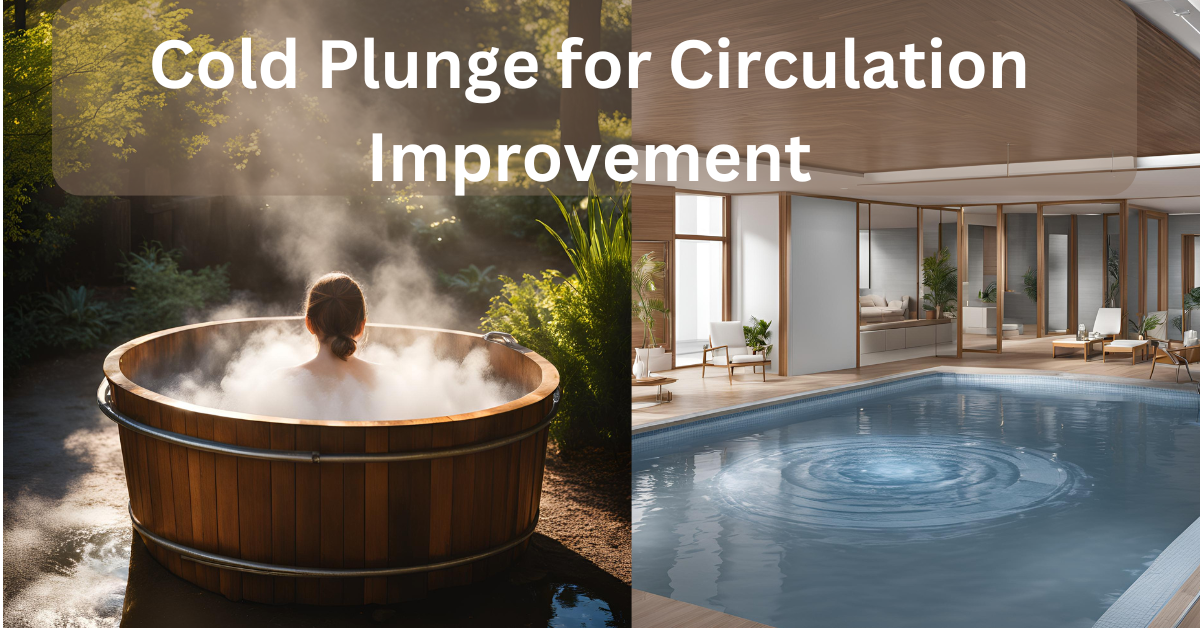Cold plunging has become an increasingly popular practice among wellness enthusiasts, athletes, and health-conscious individuals. Its benefits extend beyond mental clarity and muscle recovery, with one standout effect: improved blood circulation. This article dives into how cold immersion enhances circulation, the physiological mechanisms at play, and the long-term health benefits of incorporating cold plunges into your routine.

How Cold Plunge Enhances Blood Circulation
Cold water immersion triggers a series of vascular responses that improve circulation. Here’s how your body reacts:
Vasoconstriction and Vasodilation:
- When exposed to cold water, the blood vessels in your extremities constrict (vasoconstriction) to conserve heat.
- Upon leaving the cold environment, these vessels dilate (vasodilation) to restore normal blood flow, resulting in improved circulation throughout the body.
Increased Blood Flow to Vital Organs:
- To protect core body temperature, blood flow shifts from the extremities to essential organs like the heart, lungs, and brain.
- This redistribution boosts oxygen and nutrient delivery to these organs, enhancing their function.
Stimulating Lymphatic Flow:
Cold immersion stimulates the lymphatic system, which relies on muscle contractions and external pressure for circulation. By improving lymph flow, cold plunges help the body eliminate waste products and reduce swelling.
Health Benefits of Improved Circulation Through Cold Plunges
1. Faster Muscle Recovery
Cold water immersion is widely used in sports therapy to accelerate recovery from muscle soreness. Better blood flow helps flush out lactic acid and reduces post-exercise inflammation. Athletes often use cold plunges to reduce downtime and improve performance.
Tip: For optimal results, consider alternating cold water immersion with contrast therapy (switching between hot and cold) to further enhance circulation.
2. Reduced Swelling and Inflammation
Improved circulation prevents fluid buildup in tissues, which can otherwise lead to swelling and discomfort. Cold plunging helps manage chronic conditions like arthritis, reducing inflammation and joint pain.
You can explore more about managing arthritis with cold therapy at Arthritis Foundation.
3. Boosted Cardiovascular Health
Cold immersion stimulates the cardiovascular system, increasing heart rate and blood flow temporarily. Over time, the repeated vascular workout strengthens blood vessels, enhancing vascular health and reducing the risk of cardiovascular diseases.
If you’re looking for more information on cardiovascular fitness, visit American Heart Association.
4. Enhanced Skin and Hair Health
Cold water plunges improve skin tone by boosting circulation, which promotes the delivery of nutrients and oxygen to skin cells. This effect can reduce puffiness and enhance your natural glow.
Additionally, cold immersion helps close the hair cuticle, resulting in smoother, shinier hair.
Best Practices for Cold Plunging
To experience the maximum benefits of cold immersion for circulation, follow these tips:
- Start with Short Sessions: If you’re new to cold plunging, begin with 1-2 minutes of exposure to cold water and gradually increase the time as your body adapts.
- Ideal Temperature Range: Aim for water temperatures between 50-59°F (10-15°C) for optimal circulation benefits.
- Consistency is Key: Regular cold plunging (3-4 times a week) will yield the best long-term results for circulation and overall health.
- Listen to Your Body: Always pay attention to how your body responds. If you experience dizziness, numbness, or discomfort beyond tolerance, end the session immediately.
Scientific Evidence Supporting Cold Plunging for Circulation
Research backs the claims that cold immersion benefits circulation and cardiovascular health:
- A study published in the Journal of Physiology found that cold exposure improves vascular tone and reduces arterial stiffness.
- A 2017 meta-analysis concluded that cold immersion is effective in lowering blood pressure and improving heart function, especially for people with hypertension.
- Regular cold plunges were also shown to boost nitric oxide levels, a molecule responsible for vasodilation, which enhances blood flow to muscles and organs.
Explore these findings and more at the National Library of Medicine.
Precautions to Consider Before Cold Plunging
While cold immersion offers numerous benefits, there are some important precautions to keep in mind:
- Avoid Cold Plunging if You Have Heart Conditions: Cold immersion causes rapid changes in heart rate and blood pressure, which may not be suitable for individuals with certain heart conditions. Consult your doctor if you’re unsure.
- Use Supervision if Needed: Beginners or those with health issues should have someone nearby during the first few sessions.
- Do Not Overdo It: Staying in cold water for too long can lead to hypothermia. Stick to recommended time limits, usually 2-10 minutes.
FAQs
To see lasting benefits, cold plunging 3-4 times per week is ideal. However, listen to your body and adjust based on how you feel after each session.
Cold immersion can reduce the appearance of varicose veins by promoting vasoconstriction and improving blood flow. However, it’s not a cure. Speak to a vascular specialist for personalized advice.
Yes, but beginners should start with shorter sessions (1-2 minutes) and gradually increase exposure. Always monitor your body’s reaction during the first few attempts.
Yes! In addition to circulation benefits, cold water immersion has been linked to increased dopamine levels and improved mental clarity, making it a popular tool for stress relief.
Conclusion
Cold plunging offers profound benefits for circulation by stimulating vasodilation, enhancing cardiovascular health, and promoting faster muscle recovery. From reducing inflammation to improving skin health, the positive impact of cold immersion is backed by science and embraced by athletes and wellness enthusiasts alike.
Incorporating regular cold plunges into your routine can unlock long-term health benefits, but it’s essential to follow best practices and listen to your body. If you’re looking for a natural, invigorating way to boost circulation, a cold plunge might be the perfect addition to your wellness routine.
For more information on how cold therapy can enhance your overall well-being, check out Wim Hof’s cold therapy methods.






